Monitoring of MSW Incinerator Leachate Using Electronic Nose Combined with Manifold Learning and Ensemble Methods
Abstract
1. Introduction
2. Materials and Methods
2.1. Sample Collection
2.2. Chemical Parameters Detection for Incinerator Leachate
2.3. E-nose Detection
2.4. Data Reduction Based on Manifold Learning
2.4.1. Principal Component Analysis
2.4.2. Isometric Feature Mapping
2.4.3. Uniform Manifold Approximation and Projection
2.5. Classification and Prediction
2.5.1. Classification and Regression Tree
2.5.2. eXtreme Gradient Boosting
2.5.3. Light Gradient Boosting Machine
- (1)
- The sample points are sorted in descending order according to the absolute value of their gradient;
- (2)
- Select the first samples of the sorted results to generate a subset of large gradient sample points;
- (3)
- For 100% samples of the remaining sample set (1 − a), randomly select b (1 − a) × 100% sample points to generate a set of small gradient sample points;
- (4)
- Merge the large gradient samples with the sampled small gradient samples;
- (5)
- Multiply the small gradient samples by a weight coefficient;
- (6)
- Learn a new weak learner (CART) using the above-sampled samples;
- (7)
- Continuously repeat steps (1)~(6) until the specified number of iterations or convergence is reached.
2.6. The Evaluation of Data Processing
3. Results and Discussion
3.1. The Chemical Parameter Changes of Leachate
3.2. The Result of EN Detection
3.3. Data Reduction Based on Manifold Learning
3.4. Classification Based on EN Signals
3.4.1. Classification Result Based on LightGBM
3.4.2. Classification Result Based on XGBT
3.5. Chemical Parameter Prediction Based on EN Signals
3.5.1. Prediction Results Based on LightGBM
3.5.2. Prediction Results Based on XGBT
4. Conclusions
- (1)
- COD, BOD5, ammonia, TN, and TP of leachate were significantly changed during the processing procedure, especially for COD;
- (2)
- EN sensors offered unique and abundant characteristics of leachate samples in the headspace gas. The signals at the 80th second varied a lot in the first three process periods (LRW, LE, and ICRE), for ANE, AeroE, and MBRE samples, the signals changed not so remarkably;
- (3)
- Manifold learnings (PCA, ISOMAP, and UMAP) were applied to extract the information hidden in the headspace gas of leachate detected by EN. The first three PCs and ICs have extracted the most information from the original data (>85%), and samples of LPW, LE, and ICRE could be easily classified according to the three-dimensional space, while others were not so satisfied. UMAP outperformed the performance of PCA and ISOMAP;
- (4)
- Ensemble methods (LightGBM and XGBT) were applied to mine the relationship between EN signals of leachate headspace gas and chemical parameter changes combined with PCA, ISOMAP, and UMAP. The UMAP-XGBT model had the best classification performance, with a 99.95% accuracy rate in the training set, and a 95.83% accuracy rate in the testing set. The UMAP-XGBT model showed the best prediction ability for the leachate chemical parameters R2 higher than 0.99 in the training and testing sets.
Author Contributions
Funding
Data Availability Statement
Acknowledgments
Conflicts of Interest
References
- Kaza:, S.; Yao, L.C.; Bhada-Tata, P.; Van Woerden, F. What a Waste 2.0: A Global Snapshot of Solid Waste Management to 2050. Urban Development; World Bank: Washington, DC, USA, 2018; Available online: https://openknowledge.worldbank.org/handle/10986/30317 (accessed on 1 November 2022).
- Lippi, M.; Ley, M.B.R.G.; Mendez, G.P.; Cardoso Junior, R.A.F. State of Art of Landfill Leachate Treatment: Literature Review and Critical Evaluation. Ciência Nat. 2018, 40, e78. [Google Scholar] [CrossRef]
- Cudjoe, D.; Han, M.S. Economic feasibility and environmental impact analysis of landfill gas to energy technology in African urban areas. J. Clean. Prod. 2021, 284, 125437. [Google Scholar] [CrossRef]
- Shah, A.V.; Srivastava, V.K.; Mohanty, S.S.; Varjani, S. Municipal solid waste as a sustainable resource for energy production: State-of-the-art review. J. Environ. Chem. Eng. 2021, 9, 105717. [Google Scholar] [CrossRef]
- Ren, X.; Liu, D.; Chen, W.; Jiang, G.; Wu, Z.; Song, K. Investigation of the characteristics of concentrated leachate from six municipal solid waste incineration power plants in China. RSC Adv. 2018, 8, 13159–13166. [Google Scholar] [CrossRef]
- Chen, W.; He, C.; Zhuo, X.; Wang, F.; Li, Q. Comprehensive evaluation of dissolved organic matter molecular transformation in municipal solid waste incineration leachate. Chem. Eng. J. 2020, 400, 126003. [Google Scholar] [CrossRef]
- Jiang, F.; Qiu, B.; Sun, D. Degradation of refractory organics from biologically treated incineration leachate by VUV/O3. Chem. Eng. J. 2019, 370, 346–353. [Google Scholar] [CrossRef]
- Hu, W.; Wan, L.; Jian, Y.; Ren, C.; Jin, K.; Su, X.; Bai, X.; Haick, H.; Yao, M.; Wu, W. Electronic Noses: From Advanced Materials to Sensors Aided with Data Processing. Adv. Mater. Technol. 2019, 4, 1800488. [Google Scholar] [CrossRef]
- Eusebio, L.; Derudi, M.; Capelli, L.; Nano, G.; Sironi, S. Assessment of the Indoor Odour Impact in a Naturally Ventilated Room. Sensors 2017, 17, 778. [Google Scholar] [CrossRef]
- Bieganowski, A.; Józefaciuk, G.; Bandura, L.; Guz, Ł.; Łagód, G.; Franus, W. Evaluation of Hydrocarbon Soil Pollution Using E-Nose. Sensors 2018, 18, 2463. [Google Scholar] [CrossRef]
- Tonacci, A.; Sansone, F.; Conte, R.; Domenici, C. Use of Electronic Noses in Seawater Quality Monitoring: A Systematic Review. Biosensors 2018, 8, 115. [Google Scholar] [CrossRef]
- Jońca, J.; Pawnuk, M.; Arsen, A.; Sówka, I. Electronic Noses and Their Applications for Sensory and Analytical Measurements in the Waste Management Plants—A Review. Sensors 2022, 22, 1510. [Google Scholar] [CrossRef] [PubMed]
- Tasaki, H.; Lenz, R.; Chao, J. Dimension Estimation and Topological Manifold Learning. In Proceedings of the 2019 International Joint Conference on Neural Networks (IJCNN), Budapest, Hungary, 14–19 July 2019; pp. 1–7. [Google Scholar]
- Zounemat-Kermani, M.; Stephan, D.; Barjenbruch, M.; Hinkelmann, R. Ensemble data mining modeling in corrosion of concrete sewer: A comparative study of network-based (MLPNN & RBFNN) and tree-based (RF, CHAID, & CART) models. Adv. Eng. Inform. 2020, 43, 101030. [Google Scholar]
- HJ 1147-2020; Ministry of Ecology and Environment of the People's Republic of China. Water Qulity—Determination of pH—Electrode Method. Ministry of Ecology and Environment of the People's Republic of China. Available online: https://max.book118.com/html/2020/1129/8117023002003022.shtm (accessed on 1 November 2022).
- HJ/T 70-2001; High-Chlorine Wastewater—Determination of Chemical Oxygen Demand—Chlorine Emendation Method. Ministry of Ecology and Environment of the People's Republic of China. Available online: https://www.doc88.com/p-9982565679330.html?r=1 (accessed on 1 November 2022).
- HJ 535-2009; Water Quality―Determination of Ammonia Nitrogen―Nessler’s Reagent Spectrophotometry. Ministry of Ecology and Environment of the People's Republic of China. Available online: http://www.doc88.com/p-6836770291709.html (accessed on 1 November 2022).
- HJ 636-2012; Water Quality—Determination of Total Nitrogen—Alkaline Potassium Persulfate Digestion UV Spectrophotometric Method. Ministry of Ecology and Environment of the People's Republic of China. Available online: http://www.doc88.com/p-7187319550717.html (accessed on 1 November 2022).
- GB/T 11893-1989; Water Quality—Determination of Total Phosphorus—Ammonium Molybdate Spectrophotometric Method. Ministry of Ecology and Environment of the People's Republic of China. Available online: https://www.doc88.com/p-6764771874050.html?r=1 (accessed on 1 November 2022).
- Wilson, A.D. Review of Electronic-nose Technologies and Algorithms to Detect Hazardous Chemicals in the Environment. Procedia Technol. 2012, 1, 453–463. [Google Scholar] [CrossRef]
- Dey, A. Semiconductor metal oxide gas sensors: A review. Mater. Sci. Eng. B 2018, 229, 206–217. [Google Scholar] [CrossRef]
- Nair, A.T.; Senthilnathan, J.; ShivaNagendra, S.M. Emerging perspectives on VOC emissions from landfill sites: Impact on tropospheric chemistry and local air quality. Process Saf. Environ. Prot. 2019, 121, 143–154. [Google Scholar] [CrossRef]
- Abdi, H.; Williams, L.J. Principal component analysis. Wiley Interdiscip. Rev. Comput. Stat. 2010, 2, 433–459. [Google Scholar] [CrossRef]
- Gao, S.; Zhang, S.; Zhang, Y.; Gao, Y. Operational reliability evaluation and prediction of rolling bearing based on isometric mapping and NoCuSa-LSSVM. Reliab. Eng. Syst. Saf. 2020, 201, 106968. [Google Scholar] [CrossRef]
- Becht, E.; McInnes, L.; Healy, J.; Dutertre, C.-A.; Kwok, I.W.H.; Ng, L.G.; Ginhoux, F.; Newell, E.W. Dimensionality reduction for visualizing single-cell data using UMAP. Nat. Biotechnol. 2019, 37, 38–44. [Google Scholar] [CrossRef]
- Kumari, P.; Toshniwal, D. Extreme gradient boosting and deep neural network based ensemble learning approach to forecast hourly solar irradiance. J. Clean. Prod. 2021, 279, 123285. [Google Scholar] [CrossRef]
- Taha, A.A.; Malebary, S.J. An Intelligent Approach to Credit Card Fraud Detection Using an Optimized Light Gradient Boosting Machine. IEEE Access 2020, 8, 25579–25587. [Google Scholar] [CrossRef]
- Chang, Y.-C.; Chang, K.-H.; Wu, G.-J. Application of eXtreme gradient boosting trees in the construction of credit risk assessment models for financial institutions. Appl. Soft Comput. 2018, 73, 914–920. [Google Scholar] [CrossRef]
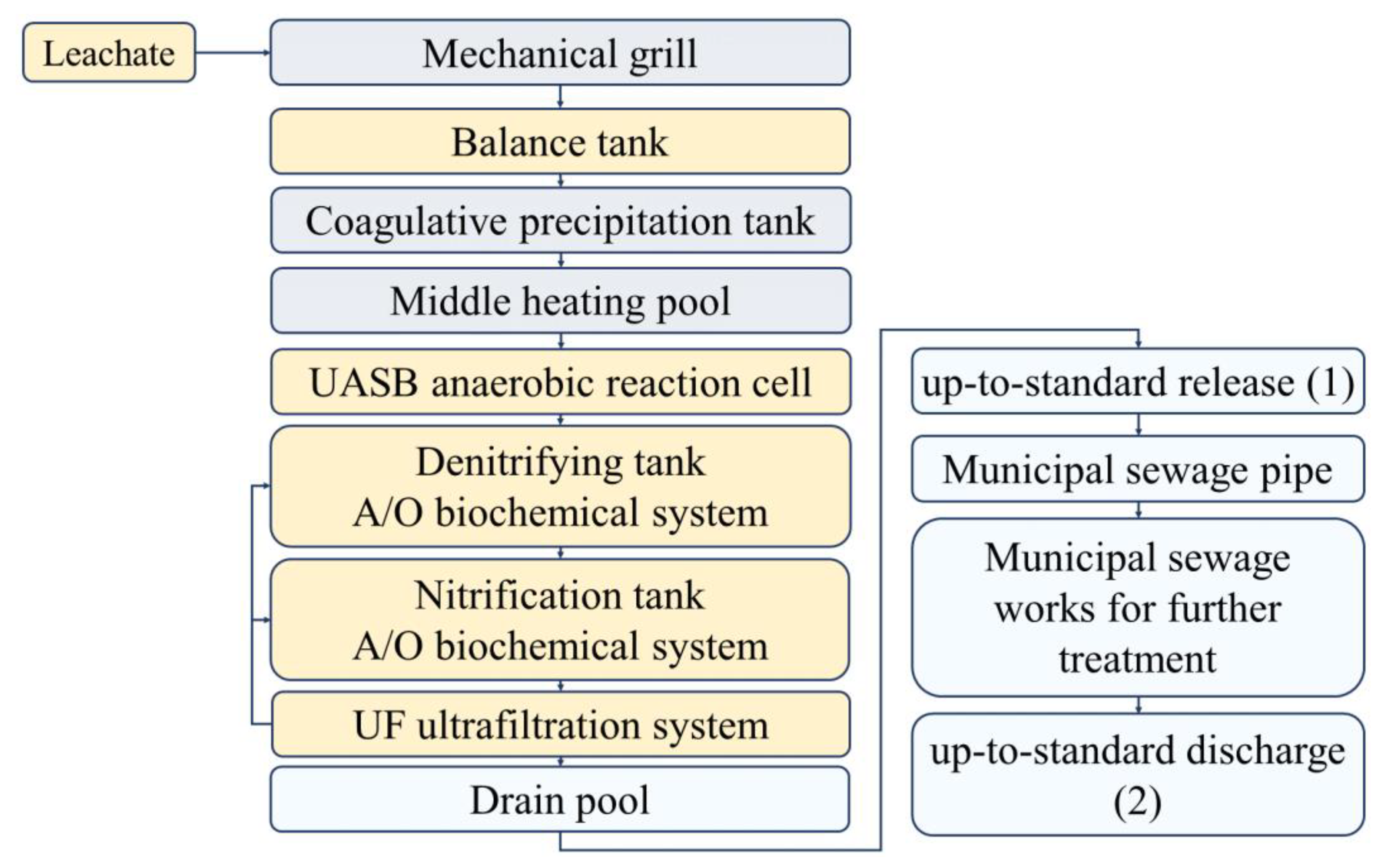
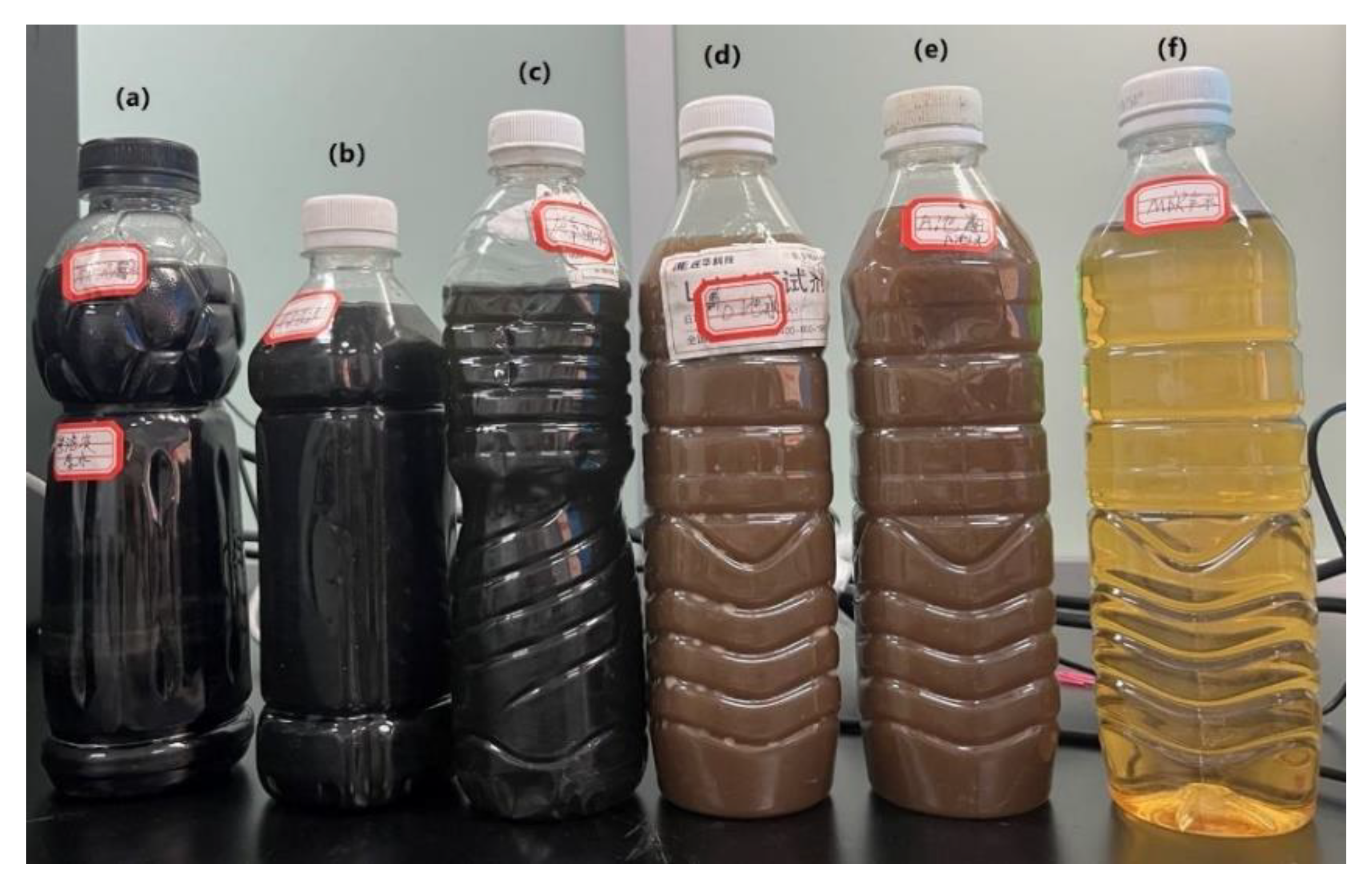

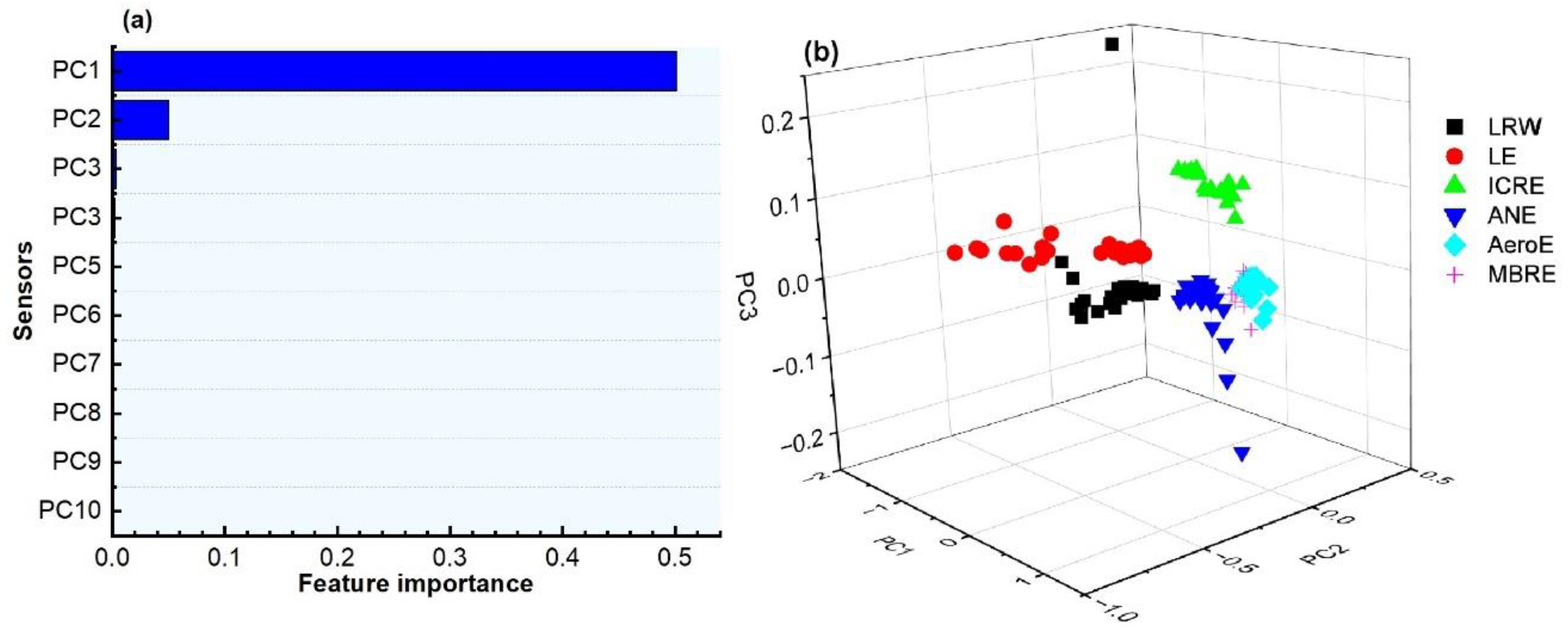
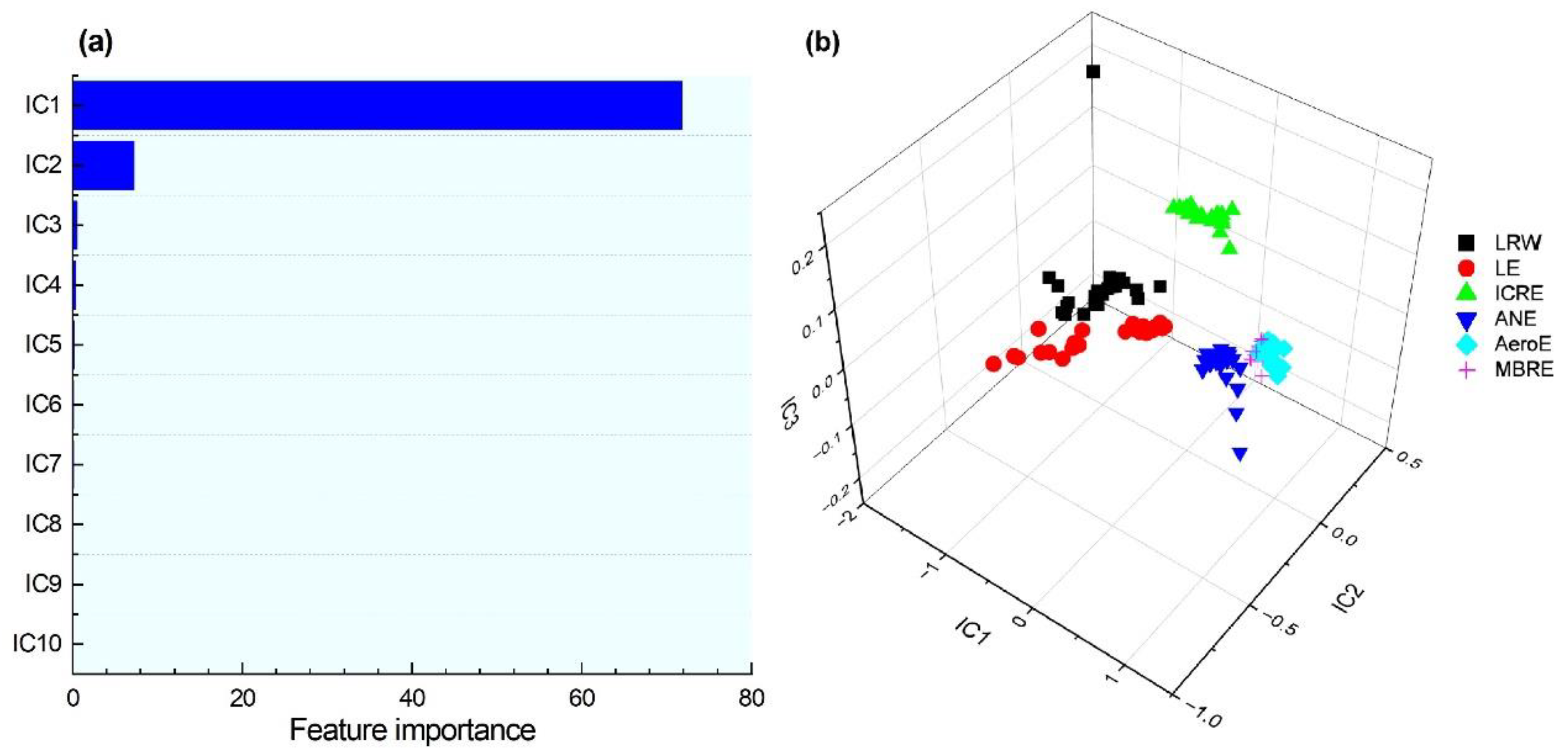

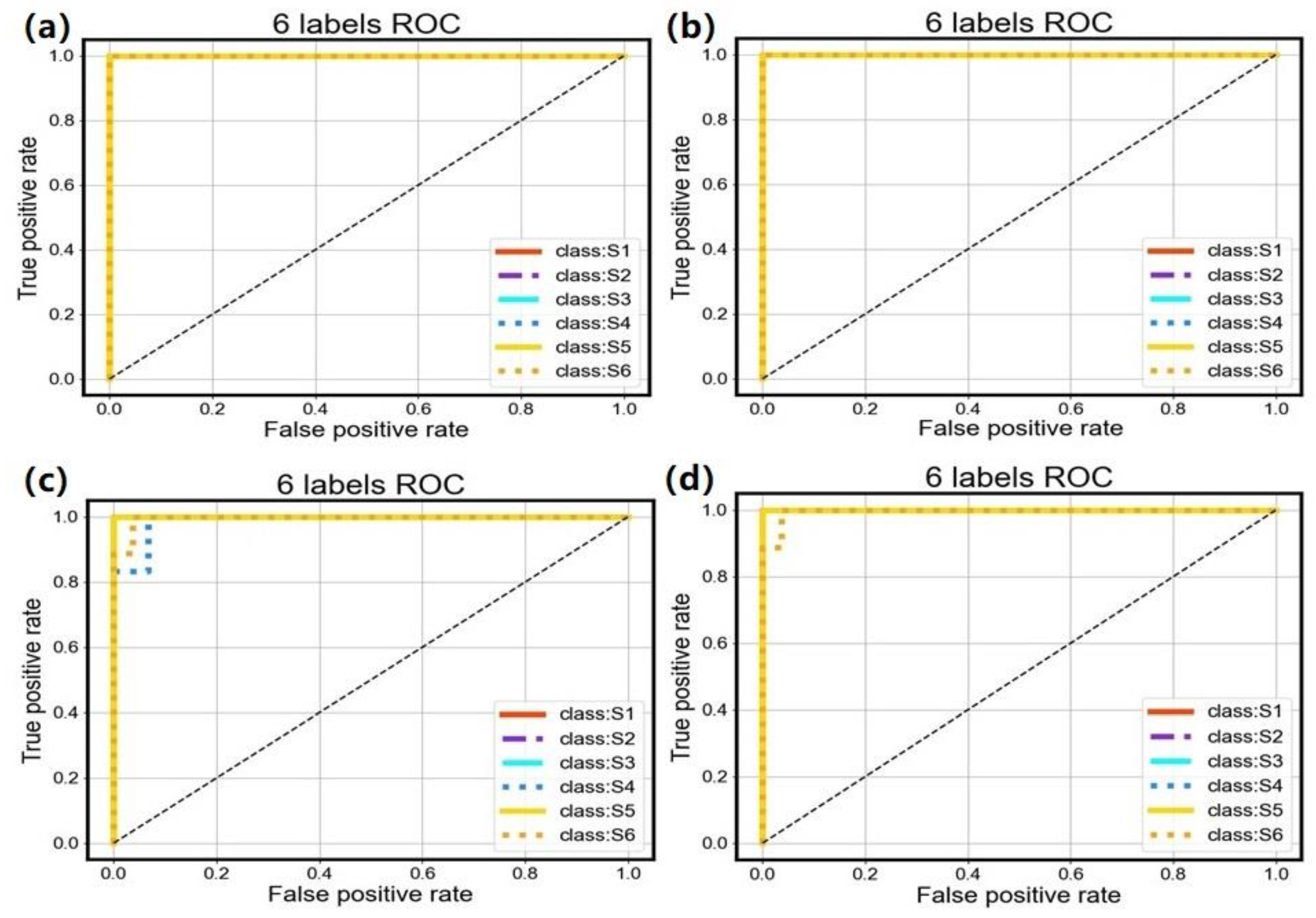

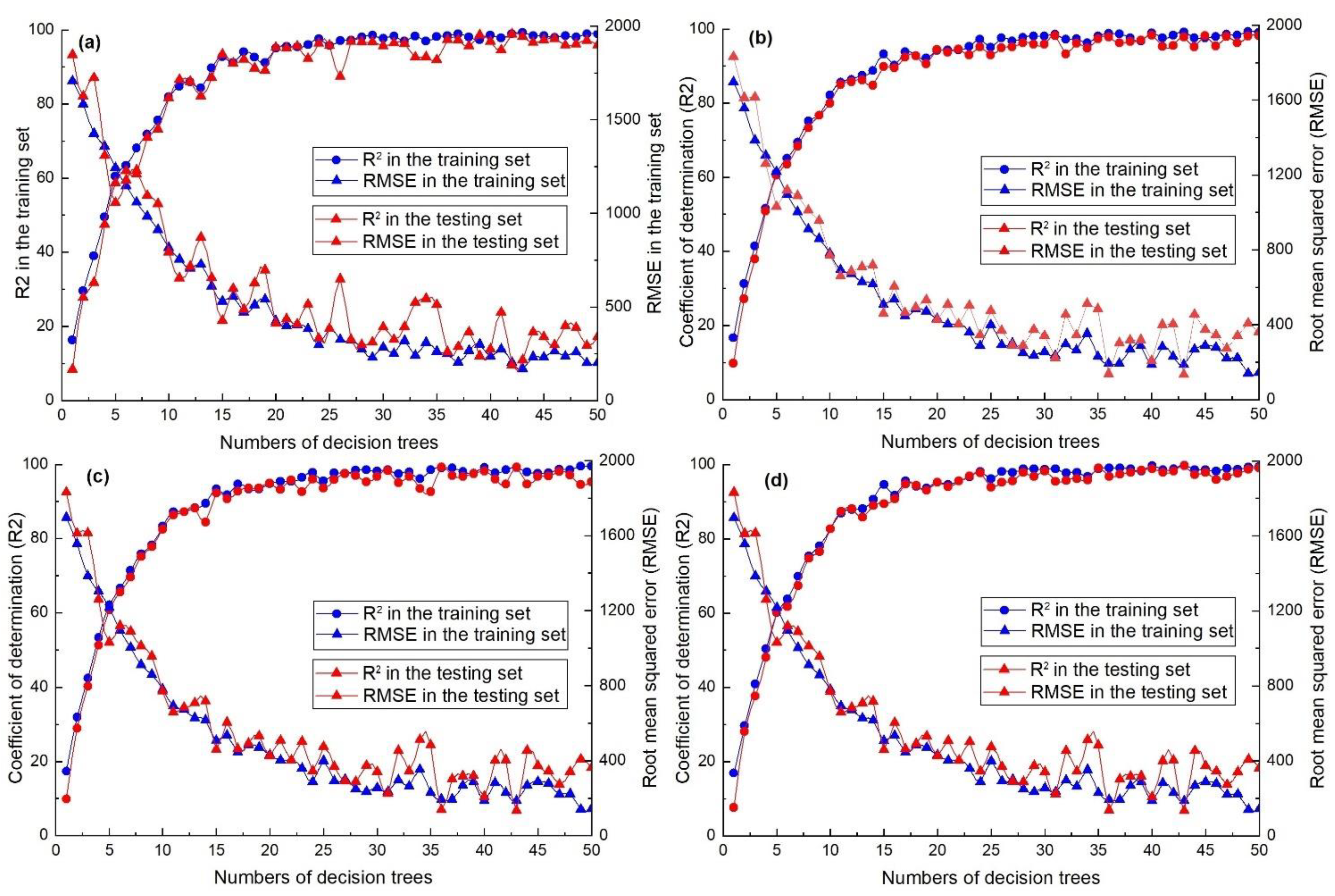
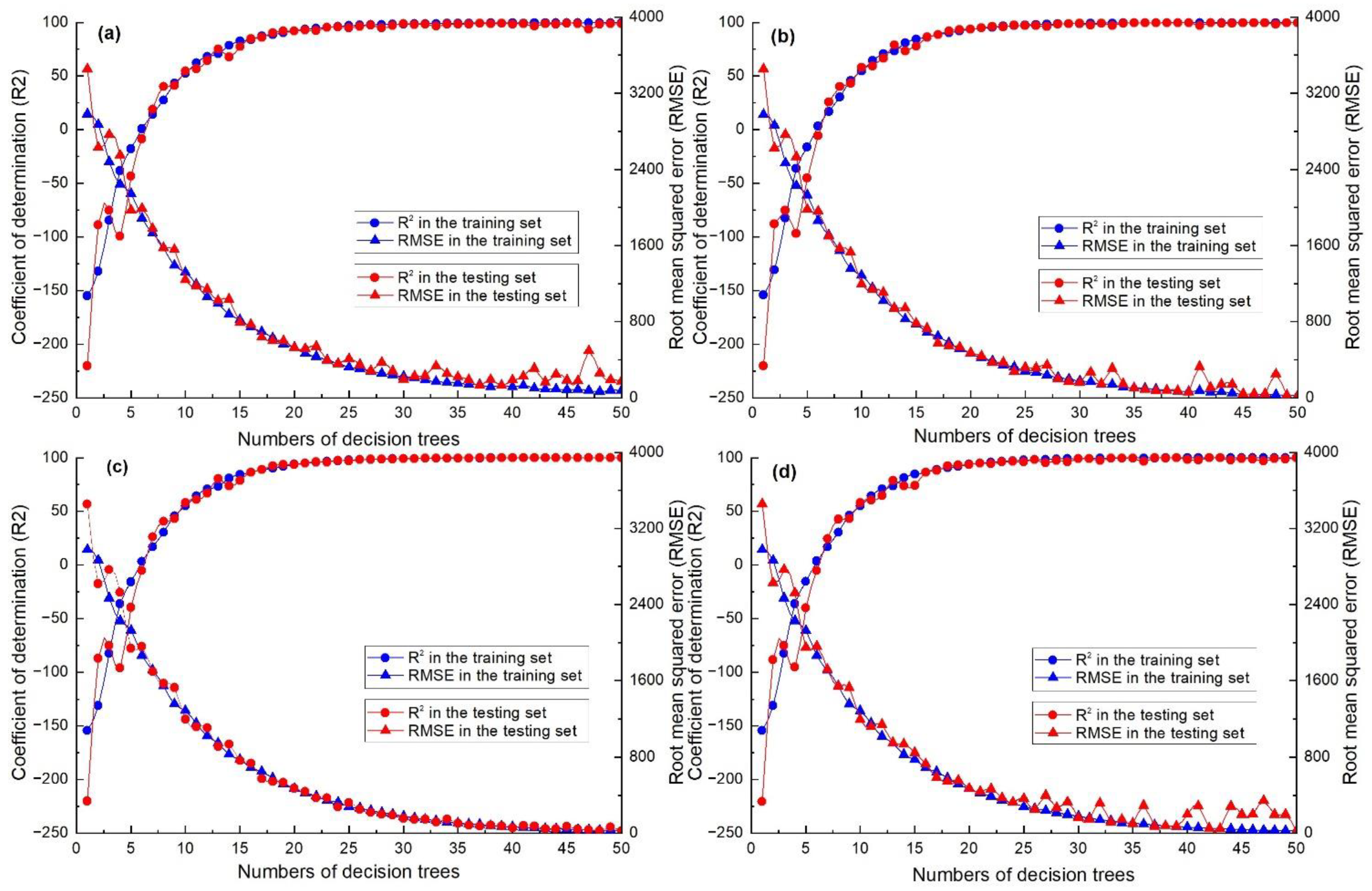
| No. | Sensor Name | General Description | Reference |
|---|---|---|---|
| S1 | W1C | Aromatic compounds | Toluene, 0.1 g/kg |
| S2 | W5S | Very sensitive with negative signal, broad range sensitivity, react on nitrogen oxides | NO2, 1 × 10−3 g/kg |
| S3 | W3C | Very sensitive with aromatic compounds | Benzene, 1 × 10−2 g/kg |
| S4 | W6S | Mainly hydrogen, selectively, (breath gases) | H2, 0.1 g/kg |
| S5 | W5C | Alkanes, aromatic compounds, less polar compounds | Propane, 1 × 10−3 g/kg |
| S6 | W1S | Sensitive to methane (environment). Broad range, similar to S8; | CH4, 0.1 g/kg |
| S7 | W1W | Reacts on sulfur compounds, or sensitive to many terpenes and sulfur organic compounds; | H2S, 1 × 10−4 g/kg |
| S8 | W2S | Detects alcohol’s, partially aromatic compounds, broad range | CO, 0.1 g/kg |
| S9 | W2W | Aromatics compounds, sulfur organic compounds | H2S, 1 × 10−3 g/kg |
| S10 | W3S | Reacts on high concentrations > 0.1 g/kg, sometime very selective (methane) | CH4, 0.1 g/kg |
| pH | COD (mg/L) | BOD5 (mg/L) | Ammonia (mg/L) | TN (mg/L) | TP (mg/L) | |
|---|---|---|---|---|---|---|
| LRW | 8b | 4.23 × 103 f | 1.10 × 103 c | 1.92 × 103 d | 2.18 × 103 c | 15.4 b |
| RPE | 8b | 6.14 × 103 e | 1.50 × 103 d | 1.70 × 103 c | 2.14 × 103 c | 24.3 c |
| ICRE | 8.1b | 2.90 × 103 d | 0.70 × 103 b | 1.54 × 103 c | 1.76 × 103 b | 24.1 c |
| AnE | 8.3b | 2.00 × 103 c | 0.52 × 103 b | 0.71 × 103 b | 1.32 × 103 a | 15.2 b |
| AeroE | 7.8b | 1.5 × 103 b | 0.10 × 103 a | 0.12 × 103 a | 1.20 × 103 a | 10.3 a |
| MBRE | 6a | 0.33 × 103 a | 0.09 × 103 a | 0.04 × 103 a | 1.13 × 103 a | 4.61 a |
| Model | Accurate Rate in the Training Set (%) | Accurate Rate in the Testing Set (%) |
|---|---|---|
| Original-lightGBM | 100 | 96.25 |
| PCA-lightGBM | 100 | 94.44 |
| ISOMAP-lightGBM | 100 | 96.81 |
| UMAP-lightGBM | 99.95 | 97.36 |
| Model | Accurate Rate in the Training Set (%) | Accurate Rate in the Testing Set (%) |
|---|---|---|
| Original-XGBT | 100 | 94.72 |
| PCA-XGBT | 100 | 93.61 |
| ISOMAP-XGBT | 100 | 95.28 |
| UMAP-XGBT | 99.95 | 95.83 |
| Data Set | R2 (Training) | RMSE (Training) | R2 (Testing) | RMSE (Testing) | Data Set | R2 (Training) | RMSE (Training) | R2 (Testing) | RMSE (Testing) | ||
|---|---|---|---|---|---|---|---|---|---|---|---|
| Original data | pH | 0.9721 | 0.2278 | 0.7217 | 0.6870 | PCA | pH | 0.9258 | 0.3716 | 0.8690 | 0.4521 |
| COD | 0.9987 | 120.72 | 0.9779 | 492.01 | COD | 0.9968 | 189.74 | 0.9916 | 302.91 | ||
| BOD | 0.9991 | 27.82 | 0.9843 | 110.01 | BOD | 0.9968 | 50.89 | 0.9893 | 94.20 | ||
| AN | 0.9991 | 40.66 | 0.9753 | 208.42 | AN | 0.9974 | 68.20 | 0.9957 | 87.06 | ||
| TN | 0.9953 | 52.35 | 0.9785 | 110.42 | TN | 0.9857 | 90.85 | 0.9694 | 132.52 | ||
| TP | 0.9978 | 0.5781 | 0.9347 | 3.11 | TP | 0.9952 | 0.8652 | 0.9739 | 2.02 | ||
| ISOMAP | pH | 0.9211 | 0.3834 | 0.8793 | 0.4286 | UMAP | pH | 0.9806 | 0.1339 | 0.9803 | 0.1721 |
| COD | 0.9968 | 189.29 | 0.9963 | 202.01 | COD | 0.9989 | 113.43 | 0.9881 | 356.88 | ||
| BOD | 0.9967 | 51.98 | 0.9921 | 80.49 | BOD | 0.9991 | 27.82 | 0.9947 | 66.30 | ||
| AN | 0.9973 | 68.55 | 0.9959 | 85.75 | AN | 0.9991 | 40.52 | 0.9938 | 105.89 | ||
| TN | 0.9837 | 96.96 | 0.9701 | 130.60 | TN | 0.9952 | 52.45 | 0.9933 | 62.07 | ||
| TP | 0.9953 | 0.8512 | 0.9844 | 1.51 | TP | 0.9982 | 0.5229 | 0.9895 | 0.5742 |
| Data Set | R2 (Training) | RMSE (Training) | R2 (Testing) | RMSE (Testing) | Data Set | R2 (Training) | RMSE (Training) | R2 (Testing) | RMSE (Testing) | ||
|---|---|---|---|---|---|---|---|---|---|---|---|
| Original data | pH | 0.9721 | 0.2278 | 0.7217 | 0.6870 | PCA | pH | 0.9258 | 0.3716 | 0.8690 | 0.4521 |
| COD | 0.9987 | 120.72 | 0.9779 | 492.01 | COD | 0.9968 | 189.74 | 0.9916 | 302.91 | ||
| BOD | 0.9991 | 27.82 | 0.9843 | 110.01 | BOD | 0.9968 | 50.89 | 0.9893 | 94.20 | ||
| AN | 0.9991 | 40.66 | 0.9753 | 208.42 | AN | 0.9974 | 68.20 | 0.9957 | 87.06 | ||
| TN | 0.9953 | 52.35 | 0.9785 | 110.42 | TN | 0.9857 | 90.85 | 0.9694 | 132.52 | ||
| TP | 0.9978 | 0.5781 | 0.9347 | 3.11 | TP | 0.9952 | 0.8652 | 0.9739 | 2.02 | ||
| ISOMAP | pH | 0.9861 | 0.1834 | 0.9803 | 0.1986 | UMAP | pH | 0.9806 | 0.1939 | 0.9833 | 0.1721 |
| COD | 0.9968 | 189.29 | 0.9963 | 202.01 | COD | 0.9989 | 113.43 | 0.9901 | 156.88 | ||
| BOD | 0.9967 | 51.98 | 0.9921 | 80.49 | BOD | 0.9991 | 27.82 | 0.9947 | 66.30 | ||
| AN | 0.9973 | 68.55 | 0.9959 | 85.75 | AN | 0.9991 | 40.52 | 0.9938 | 105.89 | ||
| TN | 0.9837 | 96.96 | 0.9701 | 130.60 | TN | 0.9952 | 52.45 | 0.9933 | 62.07 | ||
| TP | 0.9953 | 0.8512 | 0.9844 | 1.51 | TP | 0.9982 | 0.5229 | 0.9975 | 0.5574 |
Publisher’s Note: MDPI stays neutral with regard to jurisdictional claims in published maps and institutional affiliations. |
© 2022 by the authors. Licensee MDPI, Basel, Switzerland. This article is an open access article distributed under the terms and conditions of the Creative Commons Attribution (CC BY) license (https://creativecommons.org/licenses/by/4.0/).
Share and Cite
Zhang, Z.; Qiu, S.; Zhou, J.; Huang, J. Monitoring of MSW Incinerator Leachate Using Electronic Nose Combined with Manifold Learning and Ensemble Methods. Chemosensors 2022, 10, 506. https://doi.org/10.3390/chemosensors10120506
Zhang Z, Qiu S, Zhou J, Huang J. Monitoring of MSW Incinerator Leachate Using Electronic Nose Combined with Manifold Learning and Ensemble Methods. Chemosensors. 2022; 10(12):506. https://doi.org/10.3390/chemosensors10120506
Chicago/Turabian StyleZhang, Zhongyuan, Shanshan Qiu, Jie Zhou, and Jingang Huang. 2022. "Monitoring of MSW Incinerator Leachate Using Electronic Nose Combined with Manifold Learning and Ensemble Methods" Chemosensors 10, no. 12: 506. https://doi.org/10.3390/chemosensors10120506
APA StyleZhang, Z., Qiu, S., Zhou, J., & Huang, J. (2022). Monitoring of MSW Incinerator Leachate Using Electronic Nose Combined with Manifold Learning and Ensemble Methods. Chemosensors, 10(12), 506. https://doi.org/10.3390/chemosensors10120506







